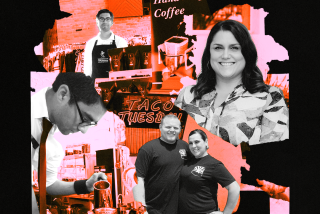Radical.FM tries a freemium business model without the premium
Why does anybody get into the online radio business?
Pandora is the king of all online music services, with 77 million active listeners at the end of last month. But even Pandora has struggled to turn a profit off its streams because the vast majority of its users don’t pay to listen to the personalized radio stations. Instead, they stick with the advertiser-supported version of the service, which generates considerably fewer dollars per listener.
Tom McAlevey thinks there’s a better way than either subscriptions or advertising. He’s putting out a tip jar and hoping listeners will donate enough to pay the bills.
McAlevey is chief executive of Radical.FM, a personalized radio service that’s available as an app either for Android or iOS phones (so far). He cut his teeth in Sweden in the dial-up Internet era, launching an advertiser-supported service called Tomsradio in 2000 that combined user-customized radio and on-demand listening years before Pandora and Spotify (or even Rhapsody).
Tomsradio lasted only a couple of years before it ran out of capital, a problem that McAlevey blames on bad timing. “It was an excellent little service,” he said in a recent interview. “You just couldn’t get [investors] to touch it.”
This time around, McAlevey isn’t wasting any time trying to sell banner ads or interstitials. “I’ve always believed that we could actually make more money based on a donation model than on a commercial model,” he said. “If people really care about something, they’re willing to do the right thing.”
For Radical.FM, the trick will be to average $3 to $4 per user each month. It helps that the service doesn’t let people play music on demand, because that cuts the royalties they pay to artists and songwriters considerably. “For an on-demand service to be profitable, in the long run a break-even would probably be around $8 to $9 a month” per user, McAlevey said.
Public radio’s 2.7 million donors in 2011 gave the equivalent of about $11 per month. From McAlevey’s perspective, that’s good news ... until you consider that these donors represented only 7% of public radio station listeners that year. The average donation per listener works out to less than $10 per year. Ouch.
Besides, even the best-known successes with the tip-jar approach to music haven’t demonstrated a way to generate sustained revenue. For instance, Radiohead’s pay-what-you-want pricing for its album “In Rainbows” contributed to its strong sales, which topped 3 million copies in various formats its first year. But that was also the last time Radiohead let fans set their own price for its material.
McAlevey says he had to sell his investors on the donations-only model, and admits that they “may not stay convinced if I can’t prove this is going to work within a year or so.” So he’s trying to improve his odds by keeping the company’s expenses low. “I joke that we’re the world’s smallest multinational,” he said, noting that his developers and customer-service representatives are in Europe and Asia while his programming and marketing staff is in Venice, Calif.
Unlike Pandora, which has a large sales force, “we don’t have to worry about sales,” McAlevey said. “So that saves us a lot.”
Still, the company won’t survive without donors. So after every few songs, it inserts a PSA-style reminder that Radical.FM relies on contributions to cover its costs, including the royalties it pays to artists and labels. It plans to update the app soon to turn off the reminders for those who donate; it also may explore ways to prod listeners more often or more intensely the longer they go without contributing.
The hope, McAlevey said, is that the company never has to block someone for free-riding. Or that it would have to start selling ads. But, he admits, “It’s kind of a big risk we’re taking.”
The company has run through about $2 million over the last couple of years developing and testing the service. It formally launches new versions of the Android and iOS apps Wednesday.
The interface is simple and intuitive, much like Pandora’s. Users specify the genres and sub-genres they like to create a custom station, then shape the station’s playlists by suggesting songs, giving tracks a thumbs up or blocking them as they play, or banning artists they don’t like. The playlists are drawn from a library of about 25 million tracks.
Not surprisingly, the apps are free. And so is the music, although McAlevey is counting on people to pay for it anyway.
Healey writes editorials for The Times. Follow his intermittent Twitter feed: @jcahealey







